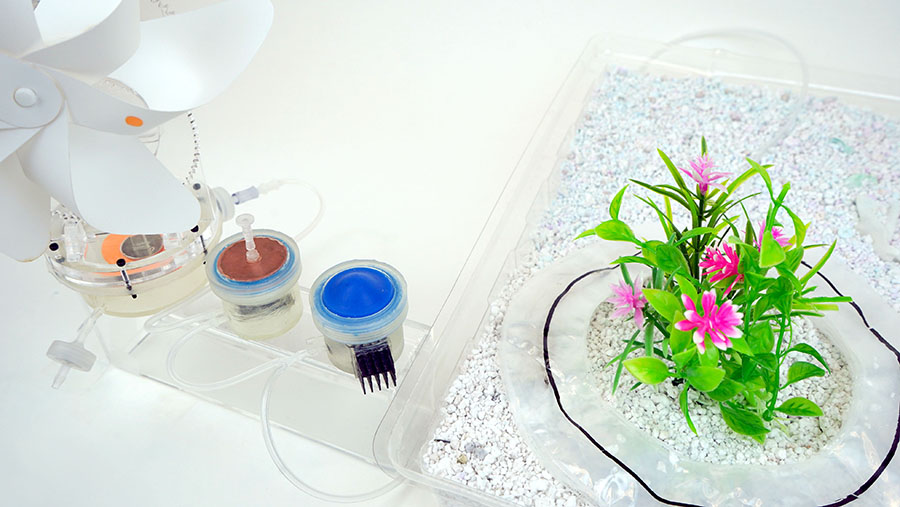Related People
Lining Yao,
HCII Researchers Develop Technologies for Harvesting Ambient Energy
Systems Store Energy as Compressed Air, Use No Electronic Controls


Systems Store Energy as Compressed Air, Use No Electronic Controls
Solar and wind power are now widely recognized as energy sources, but researchers at Carnegie Mellon University's Human-Computer Interaction Institute (HCII) suggest another source of renewable energy is largely overlooked — ambient energy.
A research team led by Lining Yao, the Cooper-Siegel Associate Professor in HCII at the School of Computer Science, has devised a number of valves, pumps and other devices that are powered by wind, water flow, sunlight and fluctuations in temperature or humidity. And — in what may seem like heresy in a major computer science school — this harvested energy is stored as compressed air, not electricity.
Just to make the heresy a bit more shocking, no electronics are used to control the system.
"It is a type of distributed energy harvesting," Yao said. "The idea is you can leverage fluctuations in your ambient environment and actually harvest a lot of energy that is normally ignored or otherwise is not the focus of classic mainstream technologies."
Qiuyu "Luca" Lu, a post-doctoral fellow in the HCII and the member of Yao's Morphing Matter Lab who led the work, said the team designed small air pumps powered by changes in temperature; fluctuations in moisture; and kinetic energy, such as wind power or water flow. The researchers also designed valves that likewise are controlled by ambient conditions, such as temperature, wind speed or the wet/dry cycle.
The researchers combined these components, along with various containers for storing compressed air, to create a number of interconnected systems found in a garden. Their work resulted in systems for dispersing seeds at the appropriate time; automatically irrigating plants or filling a bird feeder; and automatically inflating an insulating, protective collar around plants when winds turn strong and cold.
The beauty of the team's approach is that these systems don't just harvest energy. They also sense changes in the environment and use those changes to time actuation of a valve or pump, Yao said.
Lu noted that these nonelectronic pneumatic systems are at least theoretically more efficient than electricity-based systems. That's because a lot of energy is lost as heat when electricity is converted into compressed air.
"I think the nonelectronic approach can make the pneumatic system less complex," he said.
The team developed fairly small devices sufficient for demonstrating the concept, but Yao said that not all such devices need to be scaled up to the size of windmills or waterwheels. In some cases, small size may be a plus.
"If you wanted to water your plants, you might have a network of many, many of these smaller devices," she said. "They could be relatively invisible and hidden in the garden."
Their small size could also help these devices fill gaps in existing technology. "A big windmill, for instance, may need the wind to reach a certain speed before it actually can harvest energy," Yao said. "But if you mix in smaller devices you can actually be sensitive to milder air flow."
The researchers have made the models for all the devices available as open source, along with detailed instructions on how to make them.
In addition to Yao and Lu, the research team included Semina Yi, a master's student in interactive design in the School of Design; Yuran Ding, a former member of the Morphing Matter Lab; and colleagues at Tsinghua University in Beijing.
The researchers presented their work in October at the Association for Computing Machinery's 2023 Symposium on User Interface Software and Technology (UIST) in San Francisco, where they received a Best Paper Honorable Mention. This research was supported by the National Science Foundation.
More information about the research is available on the Morphing Matter Lab's project page.
By Byron Spice
For More Information
Aaron Aupperlee | 412-268-9068 | aaupperlee@cmu.edu

